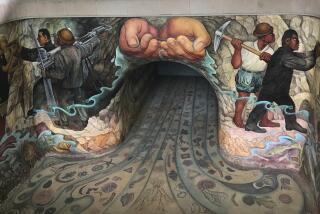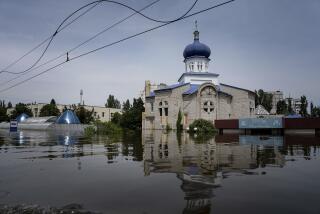Modern invaders may topple fort
- Share via
JAISALMER, INDIA — For centuries, the colossal sandstone fort that looms over this dusty town has withstood the harshly arid climate of the Rajasthani desert. Inside the citadel’s honey-colored walls, tenacious warrior families survived sieges and endured droughts by hoarding every drop of water.
These days, though, the problem with water isn’t one of scarcity. Instead, Jaisalmer is struggling with a surfeit of the stuff, an overabundance that is ravaging the historic stronghold in a way eight centuries and countless invading armies failed to do.
Residents and visitors to the fairy-tale fort now enjoy instant access to piped-in water. What was once a precious resource flows freely from the tap, gurgles down toilets and fills the washing machines of hundreds of residents and countless hotels. During the busy tourist season, which has just begun, consumption per person is more than 10 times what it was two decades ago.
But what gets channeled in doesn’t always find a way out. Thanks to woefully inadequate drainage and sewage systems, runoff has seeped into the foundations and walls of the fort, literally weakening its defenses.
Preservationists liken the fort’s predicament to a sandcastle being doused with a bucket of water. To the naked eye, the citadel and its rocky perch appear impregnable, but water easily erodes the sandstone and the soft bentonite clay that underlies much of Jaisalmer.
Over the last 20 years, several of the fort’s famed 99 bastions, stout, semicircular lookouts that scallop the perimeter, have collapsed, vanishing in a heap of dust.
A devastating monsoon in 1993 added to the infiltration, destabilizing more than 200 buildings inside the citadel, including part of a former queen’s palace and other homes with such exquisitely carved facades that the golden sandstone looks like lace.
By 1996, the situation had become dire enough to earn the fort a spot on the World Monuments Fund’s list of 100 most-endangered sites.
“Most of it is crumbling,” said Radhika Dhumal, a New Delhi-based architect who spent a year working on a restoration project here.
Crowning the heights of a 250-foot-tall hill, the fort was built 850 years ago by the Rajput ruler Rawal Jaisal, about the time the leaders of Europe were launching the Second Crusade. The citadel’s massive ramparts and forbidding gates challenged even the most dauntless enemies. Heavy stone balls still sit atop the crenelated walls, ready to be heaved with a cry onto attackers below.
On the western edge of the unforgiving Thar desert, Jaisalmer grew rich as a way station on the ancient trade route connecting India with Central Asia, along which caravans of camels transported pungent spices and other goods.
The town’s fortunes declined as seagoing trade increased. Its fate as a trading post was sealed in the last century when Pakistan, India’s archrival, was created in 1948, which cut off the overland route west and turned Jaisalmer into a remote, sleepy backwater frozen in time.
The town languished until backpackers discovered its romantic charm, its imposing fortress rising like a golden mirage in the shimmering desert heat. Soon a different kind of invading horde, one Rawal Jaisal never thought to protect against, started arriving: tourists.
“In the 1970s ... there was not a single hotel room in the whole of Jaisalmer,” said K.B. Jain, an architecture professor who began bringing students here on visits at the time. “Now there are I don’t know how many hundred.”
Unsurprisingly, most popular are the hotels and hostels inside the fort. Although the citadel towers above the town, looking severe and unapproachable, within the walls lies a hive of activity. Visitors easily get lost in the warren of homes and shops, nestled along narrow, winding lanes, or wander through beautifully carved Jain temples and bustling squares. Much of the scene seems unchanged from olden times.
But the enlarged human presence has resulted in overflowing open-air sewage gullies, overburdened drainage pipes of shoddy quality and the consequent damage to walls and foundations.
And inhabitants once accustomed to conserving every last ounce of water, drawn from wells inside the fort and an adjoining lake, became blase after local authorities delivered running water. Residents once reused the same bucket of water to wash themselves first, then their clothes and finally their homes. That frugality is gone.
“Now, every man showers one time a day, maybe two. It’s necessary,” said Ganesh Barihar, 22, a textile seller whose water tank gets replenished every morning.
Educating the populace about the importance of saving water has been the toughest task facing various preservation projects mounted by the government and by charities such as the British-based organization Jaisalmer in Jeopardy.
Young people have no memory of water as being anything other than on-demand. Activists find it hard to argue against residents’ right to enjoy a clean, modern lifestyle that others elsewhere take for granted. Some hoteliers inside the fort also accuse competitors of fabricating the water-erosion problem to attract eco-conscious tourists to their own establishments outside the citadel walls.
“They don’t understand that concept of conserving water at all,” Dhumal said. “It’s hard to get it through.”
By contrast, efforts in recent years to pave the fort’s narrow lanes, install toilets with proper plumbing and lay good-quality sewage lines have met with far more tangible success.
If more such work can be done, and if local officials and residents can be induced to practice better water management, then the glory of Jaisalmer has a shot at surviving for generations to come.
More to Read
Sign up for The Wild
We’ll help you find the best places to hike, bike and run, as well as the perfect silent spots for meditation and yoga.
You may occasionally receive promotional content from the Los Angeles Times.







